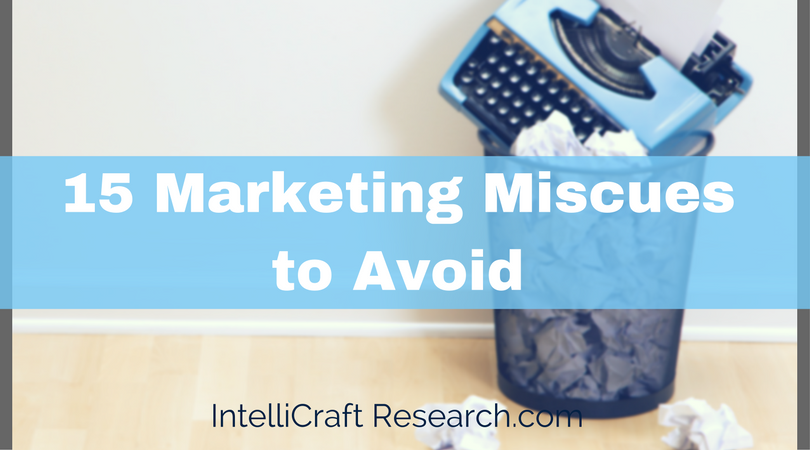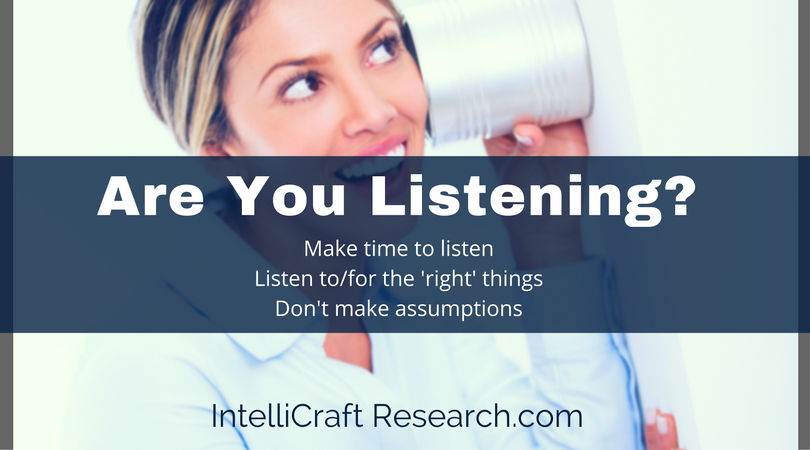15 Marketing Miscues and Tactical Errors to Avoid

15 Common Marketing Miscues – Are You Making These Audience Mistakes or Tactical Errors ?
Plus How to Avoid Them
We all make mistakes. The question is, what happens next? It’s often a hard lesson to learn, but the key is to reflect, learn from what didn’t go as planned, and try again. The best way to avoid making marketing mistakes? Learn what some of the common ones ARE, so you an avoid those traps. At least, that’s often worked for me. (You know, just like how once you know the popping sound you can avoid the flame spurts in the fire swamp.)
Common Marketing Miscues – making mistakes about our target or audience, and then making tactical errors when we carry out our marketing. There are plenty of other traps, but let’s just avoid these two areas for now, ok?
Audience Mistakes
- Thinking ‘everyone’ is your audience – marketing to ‘everyone’ is a time-killing, energy-wasting, big mistake. Sure, we want ‘everyone’ to use the library. But realistically? They won’t. And ‘they’ aren’t all listening. And ‘they’ aren’t all listening, reading, watching, or paying attention to the same social platforms, TV stations, radio, magazines, flyers, emails or neighbors. NO ONE can market to ‘everyone’. Your messages need to be specific, talk to specific segments of your core audience, ask for a specific action, and promise a specific benefit.
- No concept of your ideal user/customer – you know your products and services inside-out, you talk about your collections, your features, your events, your programs, your credentials, your experience – but do you know half as much (or hopefully more) about who uses your services, comes to which programs or events, what they use and when, how often, how each segment would use a new product or want a particular program? Well, you’d better. You can’t be vague and you can’t just put a program or event out there and hope the right people show up.
- Not enough time listening – so you DO have a good idea of your ideal user(s) and you have data on them, you’ve done market research and have their demographics. BUT … have you done a deep dive and really, REALLY listened to them? Do you know the terms THEY use to describe all your core products, services and programs – and do you then use those words/terms instead of the insider jargon? Do your marketing messages reflect their language or yours?
- Are you listening for the right things? Or are you listening to find ways to market and promote something you already decided on, that you think your audience needs or should want? Are you looking for ways that a product or event can fulfill your user’s needs, or are you listening for the underlying need and pain? C’mon, like the reference interview to figure out the problem behind the initial question.
- Making Assumptions – ok, you get that you need to be specific and talk to some people about 1 thing and others about a different thing … but it’s not working, because you assumed you knew what those segments wanted. RESEARCH! You are infopros, data masters, research specialists and the people who know how to ask a question! So do that in your marketing and question your assumptions about your audience segments and library, info center users and info users/clients. Are your using the right tone of voice, word choice, social platform, colors or images? Did you check on the way things really work for this audience segment, or are you kind of guessing based on what you think works?

Tactical Errors
- Trying to be hip, too cool for school – just like it’s important to skip the dry corporate talk, or insider jargon, or terms only librarians themselves really use – you probably need to skip the slang, text-speak, internet abbreviations and colloquialisms. Sure, sometimes in your flyers or messages to teens about programs and books for them, it MAY be okay to use their language and slang – but be careful and make sure you don’t sound or look silly or use a term that’s on its way out.
- Reinventing the Wheel – you are not the first library, info center, solo info pro or nonprofit to face today’s digital marketing and today’s tools still follow the same good marketing principles. So don’t give yourself added stress by trying to start from scratch or learn everything all at once. Do your research and see what is working with others and figure out how to apply the best bits to your library, your particular situation. Reach out to groups like: LMAO (no, really, that’s the acronym for this ACRL SIG!), Libraries and Social Media, the big library Think Tank group on Facebook (I’m not using the confusing acronym since this group has NO connection to national library orgs), the discussion group for LMCC attendees and interested library marketers, [definitely consider attending the Library Marketing and Communications Conference], listservs, and expert consultants like myself, Kathy Dempsey, Chris Olson, or the many other library consultants.
- KISS – sometimes the simplest marketing really gets the best results – simple designs, simple clear messages, singular desired action, no unnecessary complexity. What’s the MOST urgent need a particular segment of your audience or community has RIGHT NOW, and what 1 particular resource/product/service can you offer as a solution, RIGHT NOW? That’s your message. Try talking just about that, RIGHT NOW. On just ONE channel or platform where the majority of that audience is hanging out, with just ONE method of engaging and following up. Just do that and get it going smoothly, watch for results and wait before you add on something else. Sometimes a good scoop of ice cream in a bowl is all you need, not the chocolate-covered pretzel cone with sprinkles on top.
- Building on Rented Space (aka Social Media) – you can’t build a solid marketing foundation on shaky, ‘rented’ land. What do I mean? I mean putting all your marketing eggs in the social media basket. You do NOT own your Twitter Followers, your Facebook Fans or Likes, Your Instagram followers, your Pinterest peeps. The rules on those platforms change ALL. THE. TIME. The social platforms will do what is in their best BUSINESS interest, not necessarily what their users want. I don’t blame them – they are businesses after all. But I do want us all to be savvy and aware and not do so much bitter complaining when the rules inevitably change. The only space you own and control is your website. You own your customer/user database and email list. You own signage at your location. THOSE are solid assets. The rest are traffic sources and billboard space you ‘rent’ online. Use those spaces and traffic sources strategically, don’t rely on them, and don’t ignore your own home base.
- No traffic plan – you can’t just throw up a social account, a flyer, a poster or anything really and go with the ‘if you build it, they will come’ mentality. How are you using various channels to drive traffic back to your home base – to your event signup, to your registration link, to the door of the event and into the seats? What’s your plan for getting in front of the right eyeballs in your audience and directing them back where you want them, and to take the action you want? Who are you partnering with who also talks to your audience in the community and can you share traffic and eyeballs? Who is helping to drive traffic for you? Digital online traffic or physical, feet in the door traffic?
- Forgetting a CTA (Call to Action) – or giving more than one desired action in each piece of marketing. What do you want your ideal someone to DO after they see your tweet, read your post, see that spiffy flyer? Marketing = inspired action.
- Your Tactics Don’t Talk to Each Other – you’re doing lots of one-off stuff, each piece of marketing is created in a silo or by different people, your materials don’t have a consistent look, theme or voice, your social media isn’t connected to your website content and marketing, or your email or your signage or your collateral. You need to be consistent and coordinated. It’s called ‘integrated marketing’ and it saves you time and money, works more effectively and looks better too.
- Switching Things Too Soon – you need to give a campaign time to work. You also must give it enough energy, resources (budget and manpower) to have a fair chance at doing what you intended. It’s a big mistake to stop too soon, or to change the format, theme, message or channel (media) because you get worried about lack of quick result. Sure, you may be getting sick of seeing those posters, that look in your social posts, or the message you keep promoting – but remember that your audience doesn’t see all of those messages. About the time you get sick of them, your audience is just getting used to your look, recognizing you and your message. Don’t jump straight to ‘updating’ or ‘refreshing’ – first try repeating your message, or adding new channels, and then repeat again. Track what you’re doing so you can honestly see where/when the drop-off happens and you get diminishing returns.
- Not taking advantage of visuals – we are visual creatures; our brains process images MUCH faster than text. You content and your marketing must have relevant, high quality images, graphics or videos to really get high engagement and happy readers/customers/users. Getting good photos, creating slick graphics and making use of video do not have to be expensive or hard.
- Doing PR ‘Wrong’ – which usually involves throwing press releases out into the internet ether and hoping some newspaper or local TV station does something with them. Or assuming that writing and sharing the release was enough. Nope. Another tough truth, chances are high that what you wrote in the press release is boring and not relevant to local media. It might be too much about you, your org, your upcoming event. Does it have a real story underneath? Did you identify the ‘what’s in it for me’ factor for that local audience? WHY would a paper or TV station pay attention to it and use that release to create a story for THEIR audience? Have you built a relationship with the local media? Are you a source they can turn to for other information to build their stories? Do they know who you are? If the first time they hear your name is in a cold email with a press release, that’s not enough.

Consider this post to be some tough love. I don’t want to keep seeing awkward library Facebook posts, flyers with three fonts, or brochures trying to talk to literally everyone in the community at the same time. I love my library pals too much to see hard work and effort wasted! Learn the common mistakes, know them, learn FROM them, avoid them, become a marketing master.
Knowing what mistakes are possible, makes it more probable that you will avoid them in the future. Like a scout, be prepared!